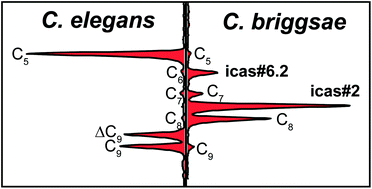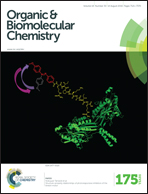Selective MS screening reveals a sex pheromone in Caenorhabditis briggsae and species-specificity in indole ascaroside signalling†
Abstract
The indole ascarosides (icas) represent a highly potent class of nematode-derived modular signalling components that integrate structural inputs from amino acid, carbohydrate, and fatty acid metabolism. Comparative analysis of the crude exo-metabolome of hermaphroditic Caenorhabditis briggsae using a highly sensitive mass spectrometric screen reveals an indole ascaroside blend dominated by two new components. The structures of isolated icas#2 and icas#6.2 were determined by NMR spectroscopy and confirmed by total synthesis and chemical correlation. Low atto- to femtomolar amounts of icas#2 and icas#6.2 act in synergism to attract males indicating a function as sex pheromone. Comparative analysis of 14 Caenorhabditis species further demonstrates that species-specific indole ascaroside biosynthesis is highly conserved in the Elegans group. Functional characterization of the dominating indole ascarosides icas#2, icas#3, and icas#9 reveals a high degree of species-specificity and considerable variability with respect to gender-specificity, thus, confirming that indole ascarosides modulate different biological functions within the Elegans group. Although the nematode response was usually most pronounced towards conspecific signals, Caenorhabditis brenneri, the only species of the Elegans group that does not produce any indole ascarosides, exhibits a robust response to icas#2 suggesting the potential for interspecies interactions.


 Please wait while we load your content...
Please wait while we load your content...